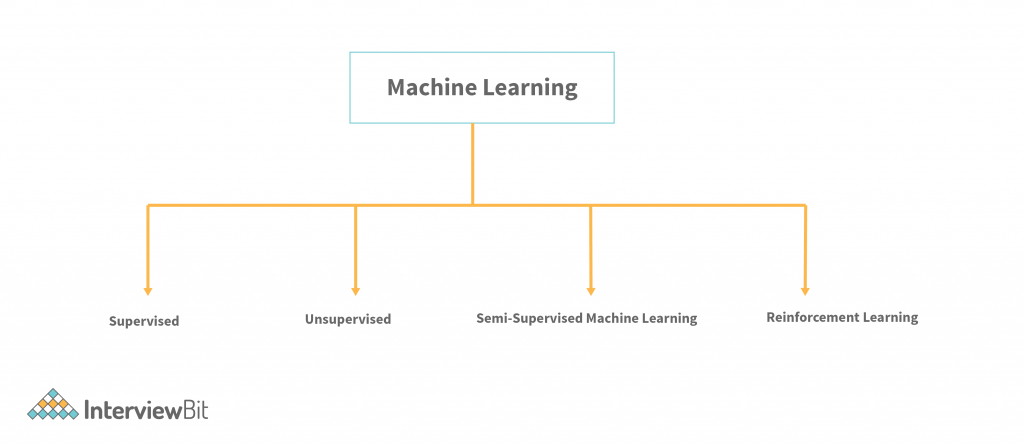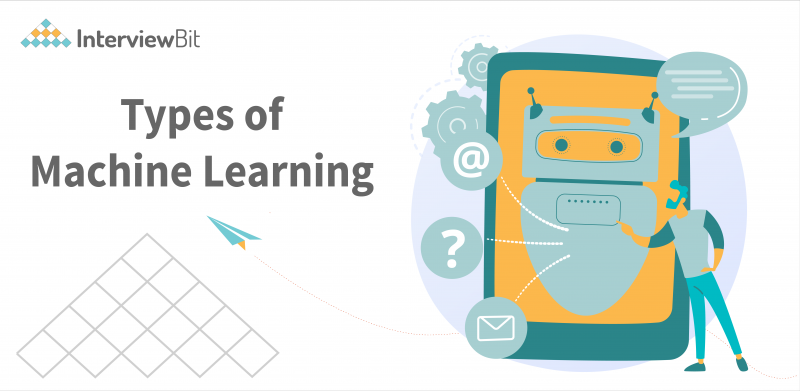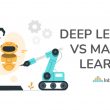Machine learning is a form of artificial intelligence that makes predictions from the data. In simple words, we can say that machine learning involves a set of algorithms that enables computers or machines to make decisions automatically without being programmed explicitly. Machine learning requires a huge amount of data based on which a machine can learn automatically, after going through past experiences make necessary improvements and finally make some predictions.

Machine Learning is closely related to humans. For example, a sports academy provides trainers who can train athletes for a sports competition based on pre-calculated data like the athlete’s weight, height, BMI (Body Mass Index) etc. Likewise, machine learning consists of a large amount of data from which machines can learn and make decisions.
In this article, we will discuss different types of machine learning.
Confused about your next job?
Types of Machine Learning:
Based on the way of learning, Machine Learning can be broadly divided into four types:
- Supervised Machine Learning
- Unsupervised Machine Learning
- Semi-Supervised Machine Learning
- Reinforcement Learning

1. Supervised Machine Learning
Supervised machine learning is considered the most popular type of machine learning. Supervised machine learning can be understood and implemented easily.
You can compare it with a situation in which a mother teaches different things to her child with the help of flashcards. As the name suggests, in supervised machine learning, machines are trained with the help of labelled datasets and after they get trained the machine predicts the result. More specifically, we can say that firstly machines are trained using the input and output and then the machine predicts the result based on the test dataset.
For example, consider that we have images of a cat and a human being as an input dataset. So firstly we will provide these images to the machine and allow it to go through and understand these images. The machine would understand the shape, size, height, colour, tail (or without tail) etc of these creatures. After the completion of this training, we will pass the input human being dataset and demand the machine to predict the output. At this moment, the machine has been trained so it will check all the traits of the dataset like shape or size and will eventually predict that the passed input is a human being.
This is how a machine is trained in supervised machine learning.
Objective:
The main aim of supervised machine learning is to do the mapping of an input variable (x) with the output variable (y).
Applications:
- Fraud detection: If you use the latest email system then you must have noticed that a spam filter is given with certain emails. Internally, these email systems use supervised machine learning techniques to understand a structure of a particular type of mail and identify malicious emails. It ensures that users are not disturbed by such types of spam mail.
- Face recognition: Most of us use Facebook, a popular social media platform. When we post a picture with more than one person in it, Facebook asks us to tag the person who is part of that picture. Facebook internally uses the supervised machine learning technique to train to bypass people’s images as an input dataset.
- Speech Recognition: Supervised machine learning is used for speech recognition also. Here, the system is trained to bypass the voices as input.
Advantages:
- Output can be predicted based on the predefined data.
- Supervised machine learning deals with the labelled dataset, hence we get an exact idea of the classes of entities.
Disadvantages:
- Complex tasks cannot be solved using supervised machine learning.
- Prediction can be true only if the test dataset is the same as the training dataset. If the test dataset is different from the training dataset then in such cases prediction might be wrong.
2. Unsupervised Machine Learning
As the name suggests, unsupervised machine learning differs from supervised machine learning. Supervision is no longer needed here. In this type of machine learning, machines are trained with the help of an unlabelled dataset and the machine predicts the outcome (without any supervision). Here, the machine is trained to recognize the patterns of the objects.
For example, consider that we have an image dataset consisting of vegetables. This dataset is passed to the machine learning model. These images are new for the machine. so, the task of the machine is to find patterns and categorize them based on these patterns.
Unsupervised machine learning is also data-driven machine learning as data and its properties are a key factor here.
Objective:
The main objective of unsupervised machine learning is to group the given dataset as per the similarities present among them.
Applications:
- Recommendation system: Have you ever used Youtube or Netflix? These platforms have a video recommendation system. These systems are trained using unsupervised machine learning.
- Network analysis: Unsupervised machine learning is also used to check for plagiarism and copyright in document network analysis.
Advantages:
- As an unlabeled dataset is involved in unsupervised machine learning hence, we can use these algorithms to carry out complicated tasks.
- Supervised machine learning can be used to carry out a large number of tasks as getting unlabeled tasks is easy.
Disadvantages:
- The predicted result can be less accurate as an unlabeled dataset is used in the case of unsupervised machine learning.
- The exact output is not used at the beginning to train algorithms.
- Dealing with an unlabeled dataset can be challenging as it involves an unlabeled dataset which cannot be mapped with the output easily.
3. Semi-Supervised Machine Learning
Semi-supervised learning as the name suggests is neither supervised nor unsupervised on its own. It lies in the middle of both: supervised and unsupervised. In this type of machine learning, a combination of both: labelled as well as unlabelled datasets are used to train the machines. Hence, it acts as an intermediate layer between supervised and unsupervised machine learning.
For example, a student learning a concept under the supervision of an instructor or teacher is an example of supervised learning. The student learning a chapter under the supervision of an instructor is an example of unsupervised learning. But if the student learns a concept by himself but under the supervision or guidance of the instructor, it would be called an example of semi-supervised learning.
Objective:
Semi-supervised machine learning was introduced to overcome the limitations of supervised and unsupervised machine learning.
Advantages:
- It overcomes the drawbacks of supervised and unsupervised machine learning.
- It is easy to understand the algorithm.
Disadvantages:
- The results of iterations may be unstable.
- These algorithms cannot be applied to network-level data.
- Semi-Supervised machine learning is not very accurate.
Applications:
Text document classifier: Semi-Supervised machine learning can be used to find a large number of labelled documents.
4. Reinforcement Machine Learning
Reinforcement machine learning is quite different from supervised and unsupervised machine learning. It involves feedback-based processes internally. In such a type of machine learning, an agent (third-party software) trains the model using hit and trial and improves the performance by learning through previous mistakes. Thus it creates a positive impact on the overall performance of the machine. It also requires an adapted environment with which the agent can connect through a feedback loop.
Types of Reinforcement:
Reinforcement machine learning is of two types:
- Positive – In reinforcement learning, when an event takes place because of a particular behaviour and it results in an increase in the strength and the frequency of the behaviour. In simple words, we can say that it leads to having a positive impact on the behaviour then is called positive reinforcement machine learning.
Advantages of positive reinforcement learning:- It maximizes the overall efficiency of the model.
- Using reinforcement more frequently may result in an overload of states that can diminish the results.
- Negative – In reinforcement learning, when the behaviour is strengthened because a negative condition is removed then it is known as negative reinforcement.
Advantages of negative Reinforcement Learning:
- Improve specific behaviour.
- Provides enough to meet up the minimum behaviour.
Reinforcement learning involves the following steps:
- Input: The input represents an initial state from which the model can start.
- Output: Since there exists a variety of solutions to a particular problem. Therefore, there can be many possible outputs.
- Training: The training relies on the input. During this process, the model returns a particular state and the user can decide to reward or punish the model depending on its output.
- The model continues to learn.
- The best solution is selected based on the maximum reward.
To understand it in a better way, we can take a rat in a maze as an example:
Suppose that, we are given a maze having r rows and c columns. The maze is made up of blocks, that may or may not have walls between them. Blocks are connected on the top, bottom, left, and right edges, except when either the block is on the outer edge of the maze, or there is a wall between the two blocks. The walls are generated randomly and are static during the training process. The maze has a target or goal point. The agent we want to train would be given a starting point and it must determine the shortest valid path from the starting point to the target point.
Advantages:
- Complex real-world problems can be solved easily using reinforcement learning techniques.
- Long-term results can be easily achieved using reinforcement machine learning as reinforcement learning minimizes the time-consuming and trial-and-error work in a stable environment.
Disadvantages:
- They are not generally preferred to carry out simple tasks.
- A large amount of data and heavy calculations are required in RL algorithms.
Applications:
- Robotics: In Robot applications reinforcement machine learning is used so that our machines can easily learn how things get done without any hardcoding.
- Video games: Reinforcement algorithms are quite popular in the game industry. It is specially used to get human-like performance. Games like AlphaGo use reinforcement algorithms.
Conclusion
So, we have discussed different types of machine learning. A basic knowledge of machine learning is a must for any person who is in the field of Information Technology. The main objective behind this learning is to teach the computer algorithms that are necessary for performing tasks efficiently.




